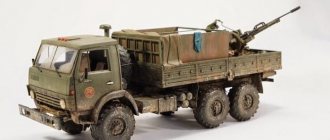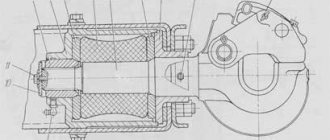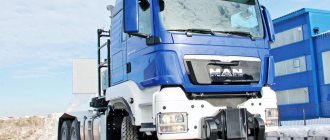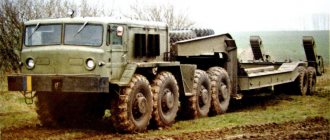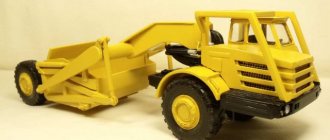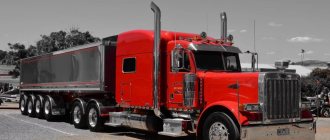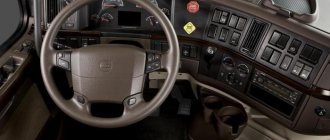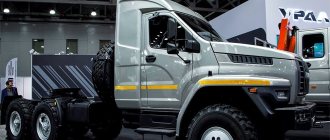V. Vasiliev, illustrations from the author’s archive
Experts often call the fifth wheel mounted on a tractor-trailer a “fifth wheel.” This unit is the only mechanical element connecting the tractor and the semi-trailer of the road train.
Part 1 Part 2
The production of fifth wheel couplings (FDU) is a profitable and well-developed business. It is handled by a reputable group of companies: Jost, Rockinger (Germany), Georg Fisher (Switzerland), Crane Fruehauf, York (UK), Fontaine Truck Equipment, Fruehauf, Holland Hitch, etc. SSUs are also produced by domestic enterprises.
The design of the SSU directly affects such operational qualities of the road train as controllability, stability, maneuverability, smoothness, cross-country ability, reliability, safety and economic indicators. In general, fifth wheel couplings consist of a detachable coupling system, a flexible mechanism and fastening parts. There are two types of SSU: pinned (pin-grip pair) and roller, or pinless (hook-roller pair). The mass of most SSUs ranges from 100 to 300 kg.
The coupling pin is mounted on the semi-trailer between its front wall and the supporting devices. There are two most common methods for installing a kingpin. A kingpin with a flange is attached to the support plate of the semi-trailer with rivets or bolts, and a kingpin without a flange is secured with a castle nut and a cotter pin.
Considerable attention is paid to the location of the fifth wheel coupling relative to the rear axle of the tractor or the balancer axis of the rear bogie (displacement of the device), which is necessary to fully utilize the load-carrying capacity of the tractor tires, and therefore the road train. This circumstance is especially relevant for the optimal distribution of loads along the axles of the most common three-, four-, five- and six-axle semi-trailer trains in operation, taking into account the requirements of the road legislation of a particular country, in many of which the loads on the axles of vehicles and trailers may be different . The exception is some models of car transporters, where the SSU, which experiences a slight vertical load, is shifted to the very end of the tractor frame to accommodate the superstructure.
SSU elements
The detachable coupling mechanism is designed to transmit forces between the links of the road train and provides the ability to rotate the semi-trailer in relation to the tractor around the axis of the coupling pin in the horizontal plane.
Detachable coupling mechanisms are divided into semi-automatic and automatic, and according to the number of grippers - into single and double grippers. SSUs with single-grip detachable-coupling mechanisms are more common. they are more reliable compared to two-jaw ones and have a safer design. In a two-grip mechanism, traction and braking forces are perceived only by the grips and fingers, while in a single-grip mechanism (with the pin grasped along its upper belt with a large diameter), traction forces are transmitted to a massive locking fist, while the grip is subjected only to compressive forces. Braking forces are transmitted directly by the base plate, while the gripping pin is relieved from longitudinal forces. Thanks to the capture of the kingpin along the upper chord, the bending moments acting on the kingpin and its fastening are reduced.
SSU base plates are either cast or stamped-welded. Cast structures, especially those made of nodular cast iron, having high rigidity and low weight, are more widespread. Modern saddle plates are characterized by a maximum mouth width of 400...460 mm, mouth angle of 40...50°, bevel angle of 8...15°. The drive handle of the detachable coupling mechanism is located to the right of the fifth wheel coupling. Its rod can be made of different lengths for the convenience of the driver. To work with different semi-trailers, modern SSUs provide the ability to install kingpins with a diameter of 2 or 3.5 inches in the same base plate. The coupling pins are made of high-strength steel, after which they are subjected to special heat treatment (hardening) and carefully checked for cracks.
The SSU is installed on the tractor frame using corner fasteners or by means of mounting plates having different configurations: from a flat plate to a spatial structure up to 150 mm high. The service life of modern pivot-type SSUs reaches 1.5...2 million km, i.e., approximately as long as the tractor is in operation.
Experience
Eduard Mironov, director of procurement of transport services, FM Logistic
“More than 60% of all cargo transportation by FM Logistic is carried out by freight transport with truck tractors. For some projects (in particular, the Shuttle), drivers have to re-couple semi-trailers several times a day. This work allows us to save our clients’ budgets.
This has an extremely negative effect on the service life of the SSU. Therefore, to increase it, drivers who have undergone special training participate in such projects.
To facilitate re-coupling and correct connection, special markings are applied in the places where this operation is carried out, allowing the tractor to take the optimal position and not damage the coupling unit.
Semi-trailers on these projects are equipped with an additional support mechanism - tripods, painted in bright colors.
In addition to protecting against situations where the trailer could tip over while uncoupled, tripods allow the driver to better navigate when hitching.”
Regulations
The dimensions of the coupling pins are regulated. The diameter of the kingpin mating surface must be 2 or 3.5 inches (50.8 or 89 mm). The choice of one of these two types (50 or 90) depends on the gross weight of the road train, semi-trailer and vertical load. King pins Ø50.8 mm are installed on semi-trailers with a total weight of up to 55 tons or with a vertical load on the SSU of up to 200 kN. For large masses (loads), coupling pins Ø89 mm are used. The dimensions of coupling pins are regulated by both national standards and the International Organization for Standardization ISO. In Russia, in addition to those mentioned, the use of kingpins with a mating surface diameter of 100 mm is allowed. The height of the saddle for SSU type 50 should not exceed 200 mm, and for SSU type 90 - 315 mm.
In a number of countries there are standards for SSUs that stipulate the mounting dimensions for attaching to the tractor frame. For SSUs operating in conjunction with semi-trailers, the coupling pin of which is made according to the international standard ISO 337, there is an international standard ISO 3842, which establishes the number, diameter and relative position of holes for attaching SSUs to tractors.
In the European Union countries, the type of SSS used is determined by the design load factor D. Its value for SSS of road trains operating on public roads is no more than 162 kN. The D-value for heavy-duty fifth wheels can reach 300 kN. An important characteristic of a specific SSU model is the size of the area (width) of the supporting surface of the saddle plate (24, 34, 36 and 40 inches).
The standards of a whole group of states, in addition, establish the angles of inclination of the fifth-wheel coupling support plate back and forth in the vertical longitudinal plane (angles β1 and β2) and the angles of inclination of the support plate in both directions in the vertical transverse plane (angles α). According to the standards adopted in the European Union, angles α must be at least ±8°. The international standard ISO 1726, which applies to tractors with semi-trailers intended for international transport, sets the angle α to be no more than 3°, and the angle β to be no less than 8°. It is clear that manufacturing companies offer their customers a joint system with higher longitudinal flexibility, so the range of change in angle β1 is from 6.5° to 29°, angle β2 ─ from 7.2° to 42°.
The standardized dimensions include: the distance from the axis of the SSU hole for the coupling pin to the rear wall of the cab or to the components and assemblies of the tractor installed behind it; radius of the rear part of the tractor; the distance from the coupling pin to the nearest part of the semi-trailer support mechanism; radius of the front part of the semi-trailer; the height of the upper plane of the tractor's SSU under rated load from the road level. All these dimensions are also specified by the ISO 1726 standard. A number of parameters are established by the ISO 4086 standard.
Installation of a control system with three degrees of freedom on a heavy-duty tractor, the transverse and longitudinal swing axes are visible
Degrees of freedom
Semi-automatic kingpin couplings are available with two and three degrees of freedom. In the first case, it is possible to longitudinally swing the semi-trailer relative to the tractor at a certain angle β and rotate the semi-trailer around the axis of the coupling pin in the horizontal plane at an angle of at least ±90°. Most truck tractors for general transport purposes, operating mainly on roads with improved surfaces, are equipped with a control system with two degrees of freedom. Compared to three-stage devices, these devices increase the stability of the road train in motion, have less weight and a reduced overall height.
Devices with three degrees of freedom are equipped with a second, but already longitudinal axis, which additionally provides the possibility of transverse swing of the semi-trailer relative to the tractor in each direction at an angle α up to 15° inclusive. In this case, the transverse and longitudinal axes can be at different heights or at the same height in the so-called universal joint. Such technical solutions are used for road trains operating off-road or intended for the transport of heavy indivisible loads, as well as for vehicles that include semi-trailers of particularly torsionally rigid construction (for example, short-wheelbase semi-trailers, dump semi-trailers, tank semi-trailers with load-bearing structures and etc.).
The use of devices with two degrees of freedom for the road trains listed above leads to the transfer of significant torsional moments to the tractor frame, which contribute to its rapid destruction. On the contrary, SSU with three degrees of freedom are devoid of these disadvantages, however, road trains with such devices are less stable during movement. Another disadvantage is that a loaded semi-trailer rests on a hinge whose center of rotation is below the semi-trailer's center of gravity. When a road train moves in turns, the resulting centrifugal force acting at the center of gravity of the semi-trailer tends to overturn the latter, which reduces the lateral stability of the road train and can lead to an accident. To prevent this from happening, sometimes SSUs with mechanical or hydraulic stabilizers are used. In road trains operating in difficult road conditions, when entering a highway with high-quality surfaces, the swing of the semi-trailer around the longitudinal axis is limited (±3°) by a special mechanism.
Andrey Savinkov, chief designer for vehicles at KAMAZ PJSC
“Before starting to move after coupling with a semi-trailer, you need to make sure that the locking mechanism for fixing the semi-trailer kingpin is closed. If a tractor is moving without a semi-trailer, the control system must always be in the closed position;
Before coupling the tractor with the semi-trailer, make sure that there is lubricant on the surface of the coupling unit and in the lubrication channels through the grease nipples.
Use only recommended lubricants. To ensure a long service life, timely lubrication of the control unit (every 50,000 km or every six months, for severe operating conditions every 25,000 km);
Elimination of overloading of the road train, which affects the service life of the SSU;
Observe the requirements of the operating manual for the control unit supplied in the glove compartment of the vehicle's cab: requirements for connecting/disconnecting the tractor with a semi-trailer, requirements for monitoring the surface of the base plate of the semi-trailer interacting with the control unit.
Please note that SSU repairs are carried out only by trained personnel in a dealership.”
If a tractor is moving without a semi-trailer, the control system must always be in the closed position;
Before coupling the tractor with the semi-trailer, make sure that there is lubricant on the surface of the coupling unit and in the lubrication channels through the grease nipples.
Use only recommended lubricants. To ensure a long service life, timely lubrication of the control unit (every 50,000 km or every six months, for severe operating conditions every 25,000 km);
Elimination of overloading of the road train, which affects the service life of the SSU;
Observe the requirements of the operating manual for the control unit supplied in the glove compartment of the vehicle's cab: requirements for connecting/disconnecting the tractor with a semi-trailer, requirements for monitoring the surface of the base plate of the semi-trailer interacting with the control unit.
Please note that SSU repairs are carried out only by trained personnel in a dealership.”
Hitch control
More and more attention is being paid to the issues of automation of control and safety when coupling and uncoupling a tractor with a semi-trailer. Often, in order to make the driver’s work easier, manufacturers produce control systems with pneumatic drives for automatic release and an electrical sensor for remote monitoring of the state of the control system. Such models with a spring-pneumatic cylinder for controlling the detachable coupling mechanism are in the arsenal of Fontaine Truck Equipment, ASF and Fruehauf.
To improve the ease of control of the hitch, Georg Fisher offers an electronic sensor safety system RECCOS, two sensors of which continuously monitor the reliability and correctness of the coupling, and another one records the distance between the semi-trailer plate and the fifth wheel coupling. Ongoing processes, including malfunctions, are displayed in the vehicle cabin in the form of sound signals and images on a special information panel. The driver, without leaving his workplace, can monitor the entire coupling process, which is carried out faster and more reliably than in traditional designs.
A similar SKS sensor system is also in the Jost production program. One of the sensors included in its composition monitors the position of the detachable coupling mechanism lock, the second sensor monitors the position of the king pin, and the third records the height of the coupling mechanism. The functionality of the SKS is enhanced by the presence of a pneumatic drive (pneumatic cylinder) for uncoupling the control system with remote control from the tractor cab, where the information display is installed.
Even more “advanced” is the KKS electronic comfort hitch system from the same company. Three touch sensors monitor the condition of the hitch, they determine its height with automatic activation of the system when coupling is carried out, and control the position of the kingpin and lock. The pneumatic drive, upon the driver's command, opens the lock to release the SSU. Setting the required height of the king pin during coupling is automatically ensured by the semi-trailer support devices, equipped with their own electric drive. A handle for manual control is included as a safety device. The kingpin is equipped with a rotating wedge with a seat connector located in it, through which the control signal is transmitted between the tractor and the semi-trailer. The remote control and control of the operations performed is located directly in front of the driver. As a result, manual labor is eliminated when servicing the coupling system, the time for coupling and uncoupling, as well as wear of mechanisms, is reduced, operational safety is increased by reducing the likelihood of incorrect coupling, and control of the condition of all elements of the system is improved.
Typically, when working with kingpin couplings, after coupling a tractor with a semi-trailer, the driver must connect their brake and electrical communications. On fifth wheel couplings created by specialists from Toussaint & Heβ, the communications are connected using transition elements during the coupling process. Upon completion, the driver from the cab can only lock the fifth wheel coupling for further movement of the road train.
Part 1 Part 2
Do we need to regulate?
In 99% of cases, the slab is visually normal. But there is a knocking sound when starting to move and stopping, so we remove the saddle and first of all check all the rubber bands and bushings and, if necessary, replace them.
In most cases, this procedure will be sufficient. Oh, and don’t forget to clean the area where the wedge runs.
We also check the wear of the SSU cushions. To do this, remove the saddle and see if it is lying on the subframe. If your suspicions are confirmed, it’s a direct route to the store for a pillow.
“You first need to check the degree of wear of the locking parts; if they are within tolerance, you can make adjustments.
It is also important to inspect the SSU for play and, if necessary, either make repairs/adjustments, or change the SSU if repair is impossible,” warns Andrey Avtomonov, head of the key account and technical support department at Iveco.
The polymer liners between the base of the saddle and the brackets are often to blame for the play.
Some people buy them new in repair kits, while others go to mechanics and take from them used metal liners from passenger car engines.
The latter option lasts much longer, although manufacturers do not encourage such a “collective farm”.
“During long-term operation, the lock and silent blocks of the saddle will require attention. Diagnosis of these aspects is included in formal maintenance.
It is prohibited to operate a tractor-trailer in cases where the saddle “beats”, since such operation may result in damage to the parts of the SSU lock.
The service interval for most SSUs is 5,000 km,” says DAF Trucks Russia technical support specialist Vyacheslav Evstropov.
If the problem is not with these consumables, then experienced truck drivers advise removing the coupling pin from the semi-trailer (if this is not possible, then a ball wrench will do, as long as the diameter matches) and insert it into the saddle.
After latching, start rotating the kingpin - if there is play, you can try to adjust the gap between the finger and the lock with a previously unlocked bolt or a special handle (depending on the SSU model).
Then drive forward a little, slowing down and finally tighten the nut. However, car manufacturers do not recommend this method.
“Adjustment of the SSU must be carried out together with the semi-trailer. The adjustment procedure is described in the operating manuals of the SSU of each individual manufacturer - V.ORLANDI (Italy), JOST (Germany) and SAF-Holland (Germany).
The manual must be placed in the glove compartment of the vehicle. And adjustment of the control system is permissible in conditions outside the dealership center,” recalls Andrey Savinkov, chief vehicle designer of KAMAZ PJSC.
SSU Ural Next
“In some SSUs from Rockinger and Georg Fisher, the gap between the coupling pin and the half-ring of the base plate in contact with it is eliminated by turning the eccentric pin installed in the support plate, or by replacing the worn half-ring.
In the SSU of the York and Jost companies, the wear of parts is compensated by pressing the locking wedges to the coupling pin manually using a screw mechanism or automatically using a spring,” explains Pavel Solomkin, general director of the AutoSpetsCenter on Kotlyakovka shopping center.
In cases of wear of parts of a non-monolithic seat on tractors for which the warranty has already expired, you can use a method proven by many - “weld on” a wedge or jaws, and then grind them.
If the cylindrical surface of the base plate itself wears out, you should contact any turner to grind out a new “horseshoe” (if the design of the plate allows you to change it) or weld the plate itself, followed by processing with an abrasive wheel. This again applies to tractors with an expired warranty.
“In addition to the prescribed regulated regular maintenance of equipment and on-the-road inspection, it is necessary to strictly adhere to the operating rules, which are also detailed in the operating instructions.
This concerns the speed of use, as well as the correct loading of the trailer and superstructure,” recalls Mikhail Masterkov, head of the service and after-sales department of Schmitz Cargobull Russland LLC.
Jost SSU on KrAZ chassis
